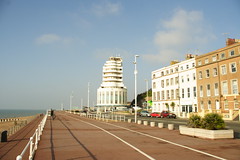 Image via Wikipedia
Image via Wikipedia
Upgrade
Friday evening: OK it was my fault! There I've said it and its true. I broke one of the rules for Ubuntu Linux which basically said "Thou shalt not use the upgrade feature in Synaptic." The rule is download the live CD run; see that everything works and then install the OS as a fresh install to the hardware.But for reasons best known to a slightly bored Linux fan on a Friday morning I decided that the best way to upgrade my perfectly workable Ubuntu 8.04 LTS (Long term support) install was to use the Synaptic function to first upgrade to the next version 8.10 and from there to 9.04 (For those wondering about the numbering scheme in use here, the first digit is the year of release and the digits after the decimal point are the month of release. Ubuntu releases two version year one in April and one in October.)
The reason for using the live CD rather than the upgrade is that this reduces the chances of something going wrong, Linux is a tapestry of applications and scripts and its all too easy for the upgrade make a mess of one or other of the many dependencies - using the live CD means you can have a good look at what you have on-screen, before you install. If everything works, you are good to go and if there is a problem, take out the CD and its back to the original OS with no problems.
All of which I happily ignored in my quest to have Ubuntu 9.04 on my desktop.
8.10
The first shock was that the upgrade was a full gigabyte of data! This is about 400mb larger than the Live CD and should have warned that the was going to be trouble ahead. It would have been quicker to go the Live CD route and by this stage it was pure laziness that was keeping me from backing up essential data and doing the job properly.Saturday afternoon: Upgrading took the better part of the night and installing the resultant download the better part of the morning. By now there was a little voice in the back of my head shouting "Stop now, there is still time! Stop!" But the same dynamic that would alway cause me to, when lost, "go just a little further" rather than ask directions, impelled me onwards.
Ubuntu 8.10 looked nice but I had heard on the internet forums that it wasn't a significant step up from the previous release so I ignored it completely and like HG Wells' time traveller propelled myself every forward.
Upgrade manager in Synaptic announced that the next upgrade would be - yes, you guessed it, a gigbyte and I had a pretty good idea that it would need another day to download and install. Commonsense would have had me back out at this point and reinstall my trusty copy of 8.04, but no working on the "just a little further" principle I started the next download...
9.04
Sunday morning: I finally had 9.10 on the desktop and glazed at its pristine beauty, it looked lovely and moved with all the speed and grace of Titanic avoiding a iceberg! I quickly that it was significantly less than fast. It may have been touted as "Jaunty Jackelope" but was like "Silicon Sloth" on my hardware. Note to the Ubuntu fan club out there, I am sure that installed on a Live CD and not hamstrung by two gigs of upgrade data it would have been a lot more speedy. It may have even run the .swf applications on my website which despite considerable time on Google and a not small amount of hair pulling I could not get it to do.One thing it did seem to do well was detect my hardware and just for once I found myself with a half way decent screen resolution. This has been a big issue for me since moving from my old CRT monitor to my TFT. For a more than decent OS I was puzzled as to why a problem with the display could only be resolved by manually editing the xorg.conf file, something calculated to put off all but the most hardened Linux fanatic. Unable to understand the way the file was put together, despite reading copious internet articles, I cheated by copying a workable config file and saving it, reasoning if it worked one time it should work another. Hmmm....?
Sunday afternoon: A couple of hours in the company of the Jackelope convinced me that, while it was probably a great OS, the way I had installed it had borked my system to the point of complete instability. Since I had installed it on my work computer and the new working week was looming with all the appeal of a pasty-faced white contestant on "Britain's Got Sod All Talent" about to do a 50 Cent rap song, and because I could not read all the files on my own website, I decided to go back to Ubuntu 8.04 also known as the "Hardy Heron."
An interesting experiment, thinks I, and now back to my original install and all will be well.
8.04
Sunday evening: Oh..!Getting the Heron back on my desktop was not difficult although somewhere along the line my back up of Thunderbird mail settings and data had been lost and I had to do the mail settings again. I was a bit annoyed about deleting the file but had been wise enough to forward all important emails to a Gmail account so I at least had a copy of anything I was likely to need. Trouble is, the screen resolution was 800x600, a setting so low as to be hardly usable, web pages zoomed off to the right and descended vertiginous downwards and my three pane email display squeezed the message into a space smaller than an estate agents' bijou residence. I hurriedly installed my config file for xorg and restarted.
Nothing...the screen was still at low resolution, Ubuntu offered to do something about this but various permutation of sudo dpkg-reconfigure -phigh xserver-xorg and Nvidia front-ends did nothing to solve my problem. Hardware detection was known to be an issue with Ubuntu, but usually an edited xorg file sorted out the problem, this time I was firmly in the low resolution barely usable brown smelly stuff.
With the clock ticking and my stupidity coming back to taunt me, I rifled through my collection of LIve CDs and happened upon the latest version of Mandriva, Mandriva 2009, complete with plasmoid widgets and reputedly a look so geogorous that it has turned down proposals of marriage from numerous Linux fanboys and girls.
Mandriva 2009
Sunday night: Mandriva installed and set up and looking good... then looking difficult to configure, then looking broken and then very broken indeed..! What was going on here? Mandriva used the latest KDE interface and the simple fact appeared to be that it was broken, whether this was something I had done or some relationship between my hardware and KDE was unclear. I tried to add short cuts and move some icons around but found that KDE was not keen on me making any changes. Initially I assumed this was simply the way that KDE worked as opposed to Gnome, which I was more used to. On Google I found out that the whole desktop was actually a floating widget and I quickly concluded that the desktop was not all it might have been. Armed with a little info on Google I tried to get a half way decent desktop sorted out. But in short order I had managed to bork the desktop to the point where I could no longer login on any graphical interface.It was time for a rethink....
I was impressed that aside from the dodgy desktop, Mandriva looked pretty good, it detected hardware with no problem and had it not been for the plasmoid widgets fouling things up, was an OS I might have stayed with. As it was with time pressing I simply did not have time to try and get it all to operate. I needed something that would work "out of the box" as they say and with even trusty Ubuntu unable to detect my monitor I had to come up with another option.
PCLinuxOS
Sunday evening + 2 large coffees: I had started my Linux voyage with PCLinuxOS but move to Ubuntu when it became clear that it would be better able to handle wireless - a function I needed at the time. I had a copy of the latest version so it went into the CD drawer and I rebooted one more time.Sunday evening + 3 large coffees: PCLOS appeared and offered me the chance to install, I clicked the appropriate icon and answered the questions and in fairly short order had the OS on the desktop. I started to configure. First thing was Firefox, I had a list of addons for the fox and the first one to install was Foxmarks (Also called X-marks) here I stored all my booksmarks and with those back I could get the rest of my desktop organised. Having earlier lost my Thunderbird data I had to do that by hand, but if I had retained the file it would have been a simple matter to copy into the ./thunderbird folder hidden in my home file. PCLOS is a KDE desktop but did not seem to have the plasmoid problems that Mandriva experienced.
Monday morning: I warmed to PLCLOS pretty quickly, it does indeed do what it says on the packet. By the morning everything up and working and I have to say I am pretty pleased with what I see. Eye candy is Compiz and looks rather better than its Ubuntu cousin. Hardware was, needless to say, detected with no problems. I plugged in a wireless dongle and it was detected, I could connect with no problems. Open Office, Amorak, Kompete and Thunderbird all worked perfectly. I have been using for about six hours now and so far the smile has not faded from my face. Its easy to use, works well and looks lovely. I would definitely recommend it for new and experienced users alike, especially since its saved my bacon
![Reblog this post [with Zemanta]](http://img.zemanta.com/reblog_e.png?x-id=c8ec3400-0b94-448e-9a82-9c3c5a2fb780)

![Reblog this post [with Zemanta]](http://img.zemanta.com/reblog_e.png?x-id=d22db86d-b37e-4be1-a8b8-200b543c360b)


![Reblog this post [with Zemanta]](http://img.zemanta.com/reblog_e.png?x-id=191a3ea1-9d44-4fc4-a0c4-76586344020b)